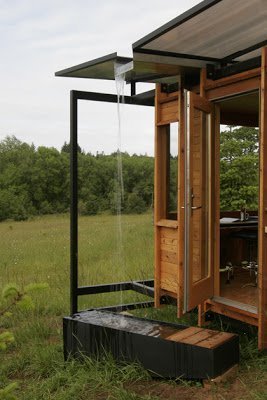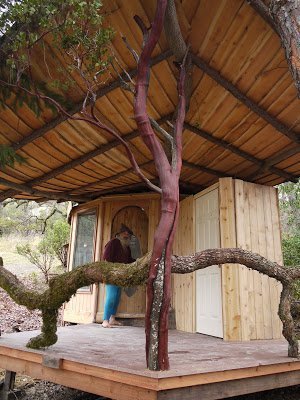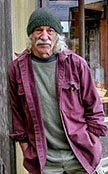Thanks to Justin for sending us this link to the full facts on the little house pictured in my post of March 24:
 “A small writing studio (just 100 sq. ft.) in the Willamette Valley, Oregon that the owner calls her “Watershed.” The owner is a philosophy professor and a well-known nature writer. She commissioned the studio as a retreat for herself and for visiting writer friends. Her first request was for a roof that would let her hear rain falling.
“A small writing studio (just 100 sq. ft.) in the Willamette Valley, Oregon that the owner calls her “Watershed.” The owner is a philosophy professor and a well-known nature writer. She commissioned the studio as a retreat for herself and for visiting writer friends. Her first request was for a roof that would let her hear rain falling.
The designer is the owner’s daughter. Erin Moore currently teaches design studios at the University of Arizona School of Architecture. She uses her own small firm, FLOAT, and her residency at MOCA Tucson to conduct small-scale projects that engage architecture with ecology.
The writing studio site is a small piece of land along the Marys River about 20 minutes from the owner’s home in town. The studio sits just uphill from riparian wetlands that are part of a project to restore hydrological and ecological function to the whole Marys River watershed.…”
https://floatwork.com/2011/05/28/watershed-2007/
 Outside of Hani’s Man Cave.
Outside of Hani’s Man Cave.
SunRay’s a master of “natural materials.” He has a sure touch in making structural frameworks from twisted, gnarly trees. The posts and beams and oak cross pieces here all look like they’ve grown together. The joints are tight – competent carpentry.
“I want my buildings to sing and dance. I don’t want them to be static. Life is motion. Live is movement. The life force is always moving through us.” – P. 59, Builders of the Pacific Coast, where there are 26 pp. on SunRay’s work
 SunRay Kelley in “Hani’s Man Cave,” which he built last year in the hills near Middleton (Clear Lake Area), Calif. (His friend Hani has a wife and 4 daughters, and SunRay thought he needed some yang space.)
SunRay Kelley in “Hani’s Man Cave,” which he built last year in the hills near Middleton (Clear Lake Area), Calif. (His friend Hani has a wife and 4 daughters, and SunRay thought he needed some yang space.)
I got there on a misty December morning, just as he was in the finishing stages. It’s a lovely little building. It improves on the nature surrounding it.
He calls this a “kit.” He cut trees and milled lumber for the 12-sided, 14-½’ wooden yurt on his property in Washington and trucked it down to California. SunRay says he can ship kits like this anywhere: https://www.sunraykelley.com
This interior wall is sculpted cob, a SunRay specialty (the secret is clay), but it’s essentially a wooden building. The porch is framed with locally-harvested manzanita, bay, and pine.
More on pp. 100-101, Tiny Homes: Simple Shelter

A reconstruction of San Francisco around 1300 A.D. from Nob Hill, looking east across the bay toward Oakland. © Laura Cunningham
“California ecology used to be much more driven by floods and fires, Cunningham said, showing with her paintings how the Great Valley would become a vast inland sea, like a huge vernal pool progressing each year from navigable water to intense flower displays to elk-grazed grassland. Lake Merritt in Oakland was a salt water inlet. On the Albany mudflats grizzly bears would tunnel into a beached humpback whale for food, joined by California condors. Every fall at the Carquinez Strait a million four-foot-long chinook salmon headed inland to spawn.
Only 300 years ago the whole Bay Area was grasslands, routinely burned by the local Indians. There were oaks in the valleys, redwoods in the Berkeley Hills, and extensive oak savannahs inland. The hills were greener more of the year than now, with fire-freshened grass attracting elk, and native perennial grasses drawing moisture with their deep roots.
Read More …
 “A small writing studio (just 100 sq. ft.) in the Willamette Valley, Oregon that the owner calls her “Watershed.” The owner is a philosophy professor and a well-known nature writer. She commissioned the studio as a retreat for herself and for visiting writer friends. Her first request was for a roof that would let her hear rain falling.
“A small writing studio (just 100 sq. ft.) in the Willamette Valley, Oregon that the owner calls her “Watershed.” The owner is a philosophy professor and a well-known nature writer. She commissioned the studio as a retreat for herself and for visiting writer friends. Her first request was for a roof that would let her hear rain falling.



